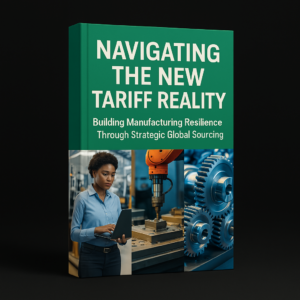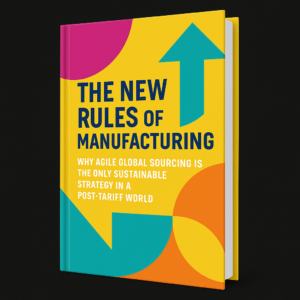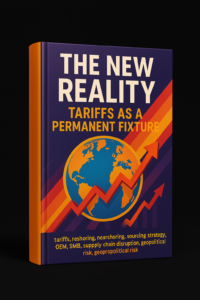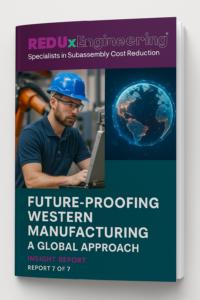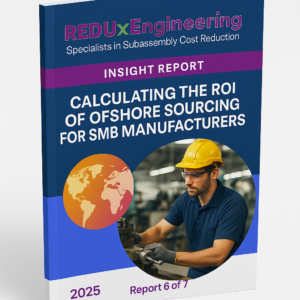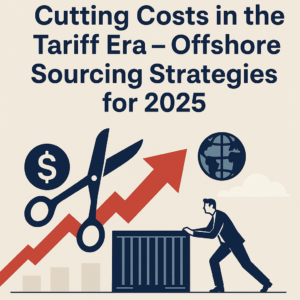
In April 2025, U.S. trade policy shifted dramatically. An executive order introduced across-the-board tariffs on imported goods, with even higher rates (“reciprocal tariffs” up to ~49%) for certain countries. Many small and mid-sized tech and hardgoods manufacturers feared this would erase the cost advantages of global sourcing.
However, a closer look at the cost structure reveals that offshore sourcing can still deliver significant net savings despite the tariffs. This report examines the new tariff landscape, compares domestic vs. offshore cost drivers, and outlines strategies to protect – and even boost – profit margins in this new era.
Tariff Impacts on Cost Structures:
The 2025 tariff regime adds a uniform 10% duty on virtually all imports. For imports from key Asian and European markets, total duty rates now range from 15% up to nearly 54% in extreme cases (for example, on many Chinese goods). On the surface, such tariffs increase the cost of foreign-made components and seem to tilt the scales toward domestic sourcing. However, tariffs are just one piece of the cost puzzle.
- Labor Costs: Manufacturing wages in the U.S. far exceed those in traditional offshore hubs. In 2025, the average U.S. manufacturing labor cost (fully loaded with benefits and overhead) is roughly $77–$116 per hour, whereas an equivalent labr in China is about $15 per hour fully loaded. Vietnam and the Philippines are lower yet. That means U.S. manufacturers pay 4 to 11 times more for the same hour of work. Even a 10–25% import tariff doesn’t bridge this enormous labor cost gap. For example, a part requiring $10 of labor overseas might incur $2.50 in tariffs (25%) – but producing it domestically could cost $40+ in labor alone.
- Material & Overhead Costs: The cost of raw materials and components is also higher in the U.S. On average, parts and materials are ~30% more expensive to source domestically than in China. Furthermore, U.S. factories face higher facility and regulatory costs. These factors contribute to a substantially higher baseline cost for U.S.-made goods, even before labor. Tariffs add to import costs, but they do not erase the 30–50% unit cost advantage that offshore production can offer on materials and labor combined.
- Capital Investment and Capacity: After decades of offshoring, many low-cost manufacturing capabilities have scaled overseas – and would take massive investment to replicate in America. For instance, China and Vietnam host modern, Industry 4.0 factories with capacities and efficiencies that “cannot currently be achieved elsewhere”. U.S. companies are now scrambling to build domestic capacity (Apple alone announced a $500 billion U.S. investment drive to onshore production), but building new factories takes years. Estimates suggest it would take 20 years and trillions of dollars to fully meet U.S. demand with domestic production. In the meantime, domestic supply will be constrained – driving up prices for local contract manufacturing and making lead times “wildly unpredictable”. This capacity lag means domestic sourcing comes with hidden costs: production delays, expediting fees, and quality risks from overstrained suppliers.
Offshore Sourcing: Still a Net Gain (Even After Tariffs):
Taking all cost factors into account, offshore sourcing remains highly cost-effective, and a much safer bet for price and lead time stability. REDUx Engineering’s analysis finds that for U.S. manufacturers, a balanced global sourcing strategy can yield 0%–33% net cost savings on parts and subassemblies, even after accounting for the new tariffs.
In other words, worst case, a company breaks even versus domestic production – and more often, they still save a substantial percentage. At the same time they gain price and supply stability and a high likelihood of growing savings such as those that Vietnam already began negotiating with the White House. Within 48 hours, both sides were expressing confidence that Vietnam’s 46% tariff would be reduced to 0% shortly.
For manufacturers in allied high-cost countries (Western Europe, Canada, etc.), the savings are even greater – on the order of 19%–49% – because their domestic costs are higher and U.S. tariffs on their goods are a flat 10%. This range of savings is consistent with real-world cases: e.g., an electronics OEM recently achieved a 32% cost reduction on key components by offshoring to Vietnam, even with tariffs, translating to several million dollars saved annually.
It’s important to note these savings aren’t theoretical – they are being realized by companies that selectively offshore the right parts. Critical high-volume components (like PCB assemblies, metal castings, and plastic molded parts) see the biggest gap. For example, an assembly that costs $100 in-house in the U.S. might be sourced for $65–$75 offshore (inclusive of tariffs and shipping) due to the labor/material advantage – a clear 20–35% reduction in unit cost. Those savings directly bolster profit margins or can be passed on as price reductions to gain market share.
Strategies for Maximizing Savings Post-Tariffs:
To capture these benefits safely in the tariff era, manufacturers should adopt a strategic approach:
- 1. Re-evaluate Your Cost Breakdown: Identify which cost elements (labor, material, overhead) dominate each component’s price. The higher the labor/content ratio and the more commoditized the materials, the more likely offshore sourcing will yield large savings. Focus on subassemblies where domestic labor adds disproportionately to cost.
- 2. Leverage Tariff-Mitigating Supply Chains: Not all offshore options are equal under the new rules. Consider shifting sourcing to countries with more favorable tariff status. For instance, Mexico now benefits from USMCA tariff exemptions on many goods (avoiding the 10% tariff), and several Southeast Asian nations face moderate tariffs compared to China. A “China+1” strategy – diversifying some production to Vietnam, Malaysia, or Mexico – can preserve low costs while reducing tariff exposure.
- 3. Optimize Design and Shipping: Work with suppliers (or engineering partners) to implement Design for Manufacturability improvements that reduce cost, which can offset tariffs. Also, shipping in bulk and using U.S. distribution can minimize the tariff impact (e.g. via Foreign Trade Zones, where duties are paid only when goods enter U.S. commerce). These tactics ensure every possible efficiency is captured.
- 4. Partner with Offshoring Specialists: Engaging experts in global sourcing can accelerate the cost reduction process and boost manuverability in the face of future change. A managed offshoring service can quickly tap pre-vetted factories in low-cost countries and coordinate logistics. This avoids the trial-and-error costs a firm might incur going it alone. For example, REDUx Engineering offers a contingency-based program (no up-front fee) that guarantees savings – typically 15%–25% cost reductions – by optimizing designs and supplier selection across tariff-friendly locales.
Conclusion:
Despite new tariffs raising import costs, the economics of offshore sourcing remain compelling in 2025. The substantial differences in labor, material, and manufacturing overhead between the U.S. and countries like China, Vietnam, and Mexico far outweigh a 10%–25% tariff in most cases. For SMB manufacturers ($20M–$250M revenue) who are battling rising domestic costs, strategic offshore sourcing is a proven path to protecting margins. Done correctly, it can deliver immediate savings on the order of tens of percent – turning a would-be tariff setback into a competitive advantage.
Manufacturers that seize this opportunity will not only see 33%+ cost relief on critical components but also position themselves to invest those savings in growth (new product development, hiring, etc.). In short, tariffs have raised the bar – but with the right strategy, offshore sourcing still clears it, delivering sustainable cost reductions in 2025 and beyond.
Making it Safe, Flexible and Successful:
REDUxEngineering can be your “Managed Offshore Sourcing” department, providing SMB manufacturers the on-demand specialized expertise, pre-vetted CM partners. multiple international destinations, language skills, long-term regional relationships and on-site QA staff needed to safely, efficiently, and quickly tap into the savings that diversified global sourcing has delivered to multi-nationals for decades. Hop on our calendar for a 20 minute briefing: https://app.apollo.io/#/meet/david_orton_b36 , or email us with times that work for you: [email protected].
Sources:
- EFulfillment Service – “Impact of April 2025 U.S. Tariffs on Products, Industries, and E-Commerce Sellers.” (April 2025) .
- REDUx Engineering – “The Numbers Don’t Lie: Long Live Offshore Sourcing!” White Paper (Apr 2025).
- Reuters – “Trump’s sweeping new reciprocal tariff regime” (Apr 3, 2025).
- Reuters – “Apple plans $500 billion in US investment…” (Feb 24, 2025).
- REDUx Engineering – Client Case Data (2025) – Electronics OEM cost reduction example (internal).
- REDUx Engineering – REDUxTARIFFS Program Details, reduxengineering.com (2025).
- EFulfillment Service – Tariff management strategies (April 2025).

